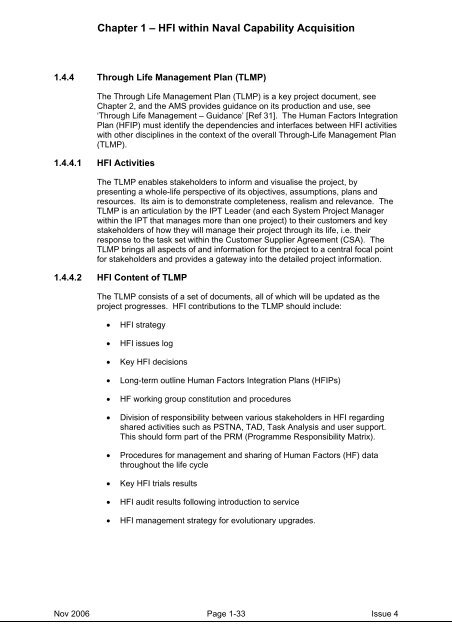MAP-01-010 HFI Management Guide - Human Factors Integration ...
MAP-01-010 HFI Management Guide - Human Factors Integration ...
MAP-01-010 HFI Management Guide - Human Factors Integration ...
You also want an ePaper? Increase the reach of your titles
YUMPU automatically turns print PDFs into web optimized ePapers that Google loves.
Chapter 1 – <strong>HFI</strong> within Naval Capability Acquisition<br />
1.4.4 Through Life <strong>Management</strong> Plan (TLMP)<br />
The Through Life <strong>Management</strong> Plan (TLMP) is a key project document, see<br />
Chapter 2, and the AMS provides guidance on its production and use, see<br />
‘Through Life <strong>Management</strong> – Guidance’ [Ref 31]. The <strong>Human</strong> <strong>Factors</strong> <strong>Integration</strong><br />
Plan (<strong>HFI</strong>P) must identify the dependencies and interfaces between <strong>HFI</strong> activities<br />
with other disciplines in the context of the overall Through-Life <strong>Management</strong> Plan<br />
(TLMP).<br />
1.4.4.1 <strong>HFI</strong> Activities<br />
The TLMP enables stakeholders to inform and visualise the project, by<br />
presenting a whole-life perspective of its objectives, assumptions, plans and<br />
resources. Its aim is to demonstrate completeness, realism and relevance. The<br />
TLMP is an articulation by the IPT Leader (and each System Project Manager<br />
within the IPT that manages more than one project) to their customers and key<br />
stakeholders of how they will manage their project through its life, i.e. their<br />
response to the task set within the Customer Supplier Agreement (CSA). The<br />
TLMP brings all aspects of and information for the project to a central focal point<br />
for stakeholders and provides a gateway into the detailed project information.<br />
1.4.4.2 <strong>HFI</strong> Content of TLMP<br />
The TLMP consists of a set of documents, all of which will be updated as the<br />
project progresses. <strong>HFI</strong> contributions to the TLMP should include:<br />
• <strong>HFI</strong> strategy<br />
• <strong>HFI</strong> issues log<br />
• Key <strong>HFI</strong> decisions<br />
• Long-term outline <strong>Human</strong> <strong>Factors</strong> <strong>Integration</strong> Plans (<strong>HFI</strong>Ps)<br />
• HF working group constitution and procedures<br />
• Division of responsibility between various stakeholders in <strong>HFI</strong> regarding<br />
shared activities such as PSTNA, TAD, Task Analysis and user support.<br />
This should form part of the PRM (Programme Responsibility Matrix).<br />
• Procedures for management and sharing of <strong>Human</strong> <strong>Factors</strong> (HF) data<br />
throughout the life cycle<br />
• Key <strong>HFI</strong> trials results<br />
• <strong>HFI</strong> audit results following introduction to service<br />
• <strong>HFI</strong> management strategy for evolutionary upgrades.<br />
Nov 2006 Page 1-33 Issue 4
















